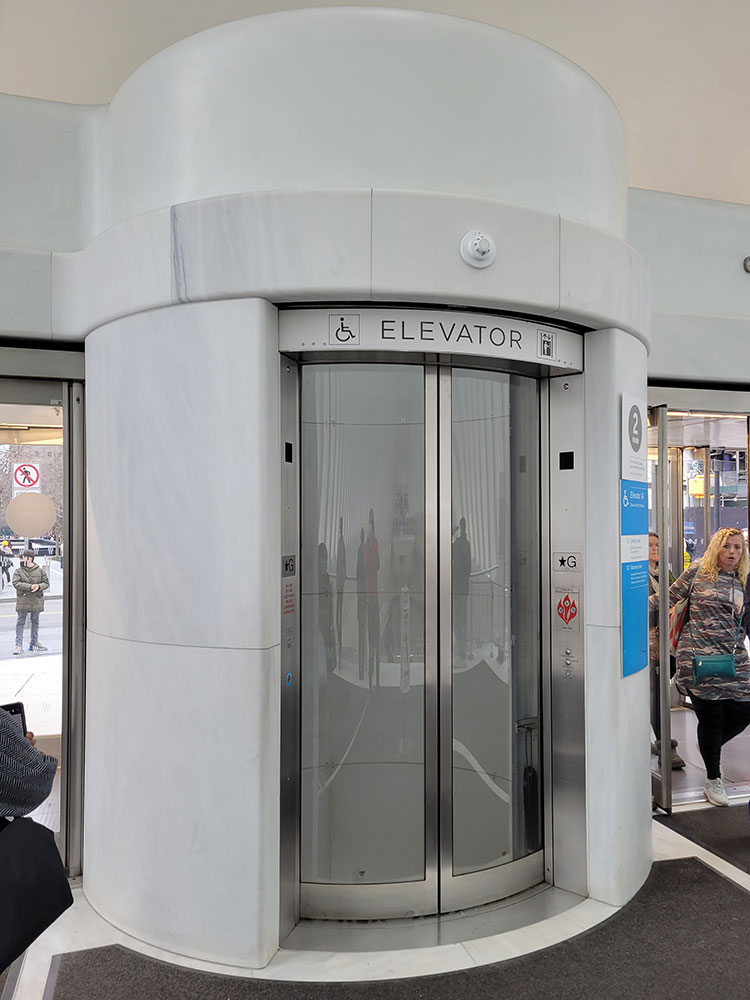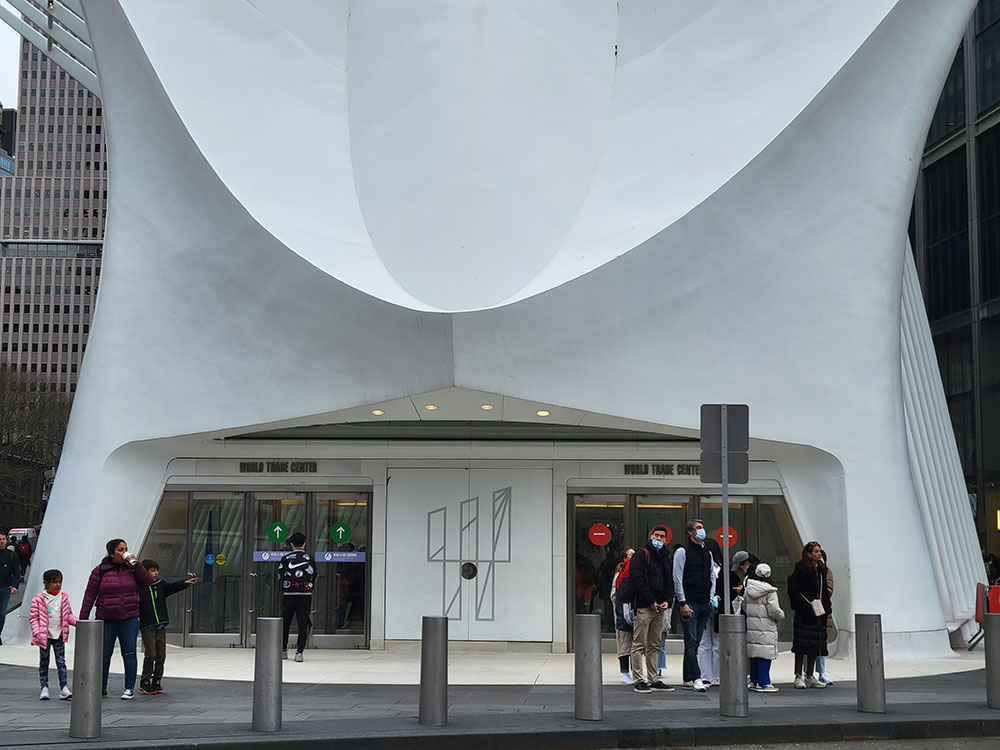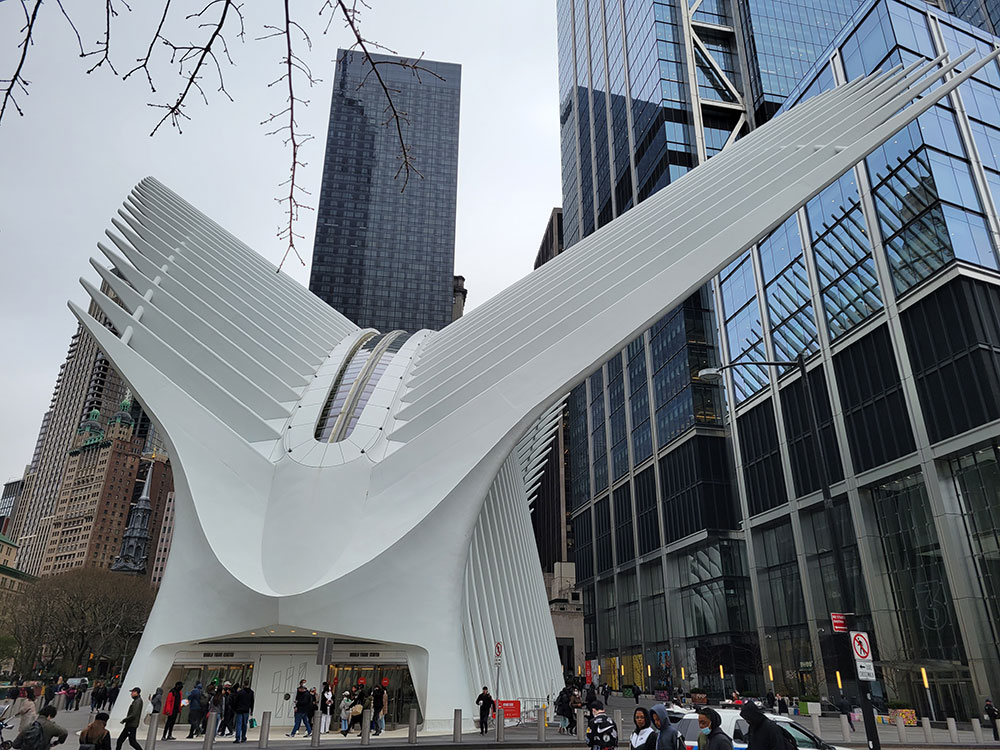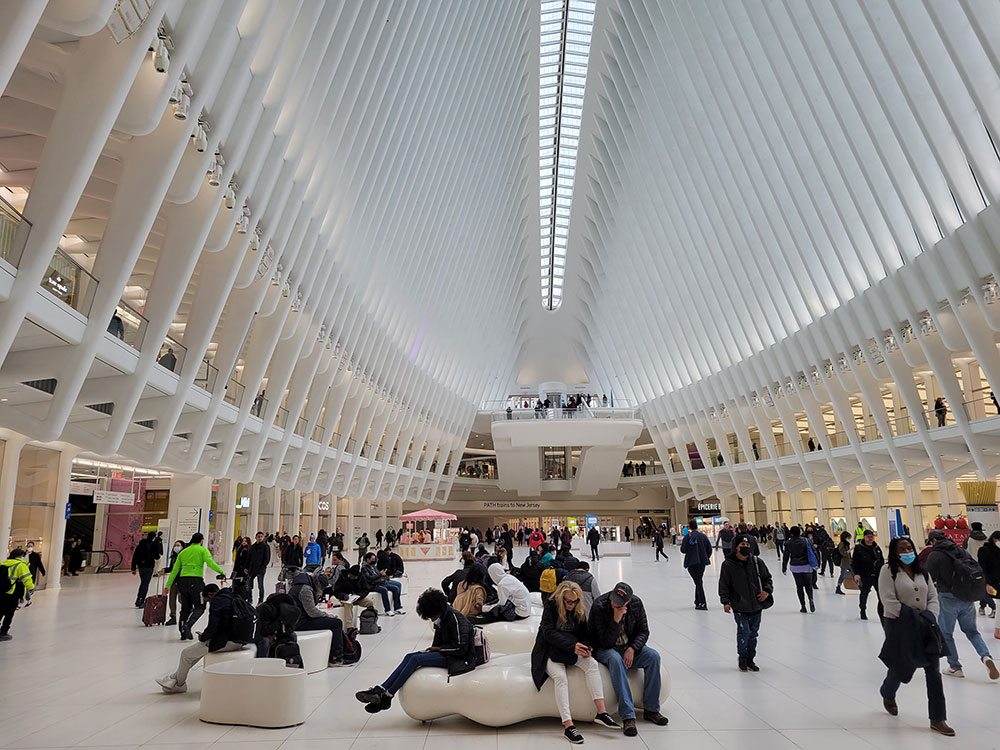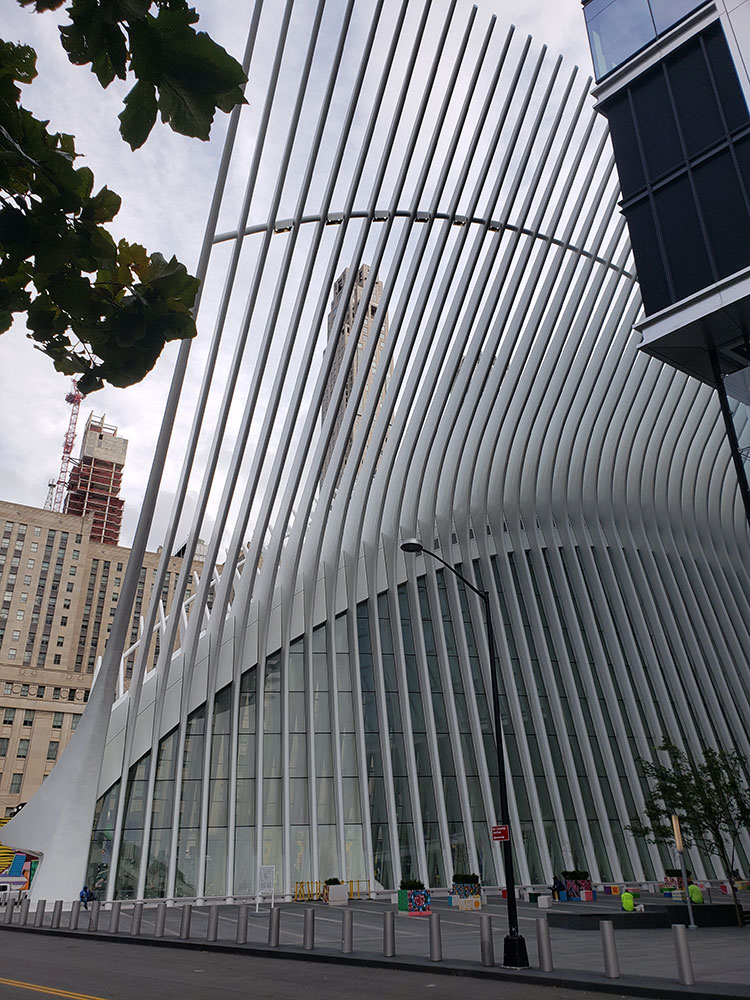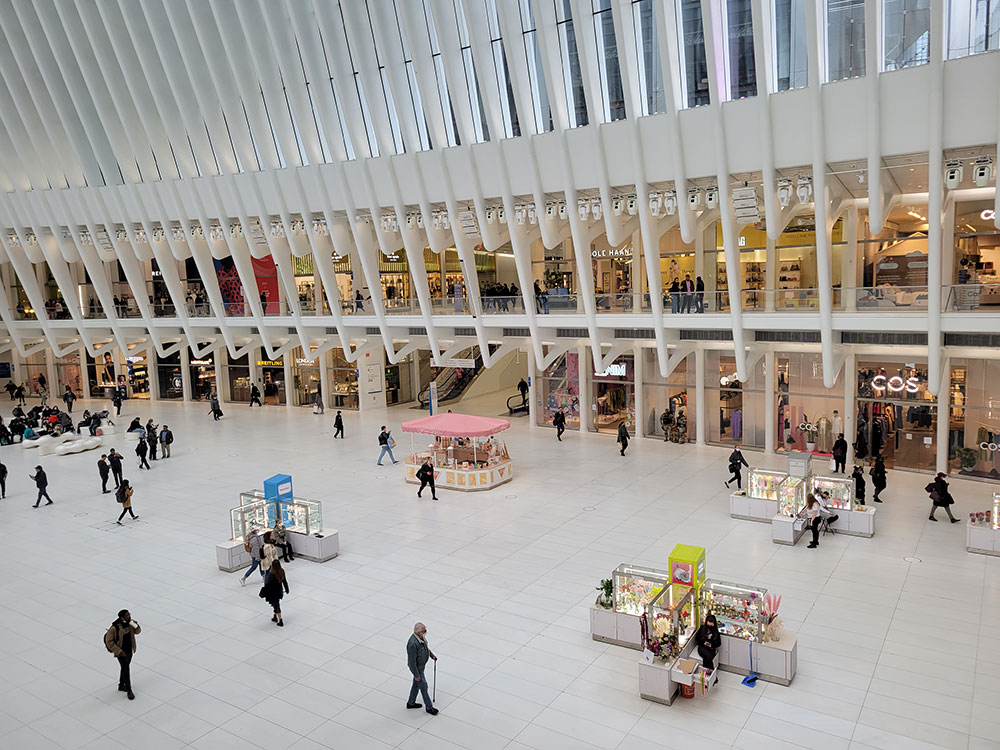Designed by the Spanish architect Santiago Calatrava, station consisting of white ribs that interlock high above the ground and interior containing two underground floors, which house part of the Westfield World Trade Center mall
General Information
Churchyard open from 7am to 6pm daily
World Trade Center is a terminal station on the PATH system, within the World Trade Center complex in the Financial District of Manhattan, New York City. It is served by the Newark-World Trade Center line at all times, as well as by the Hoboken-World Trade Center line on weekdays, and is the eastern terminus of both.
The World Trade Center station is near the site of the Hudson and Manhattan Railroad (H&M)'s Hudson Terminal, which opened in 1909. The Port Authority of New York and New Jersey bought the bankrupt H&M system in 1961, rebranded it as PATH, and redeveloped Hudson Terminal as part of the World Trade Center. The World Trade Center station opened on July 6, 1971, as a replacement for Hudson Terminal, which was closed and demolished as part of the construction of the World Trade Center. Following the September 11, 2001 attacks, a temporary PATH station opened in 2003 while the World Trade Center complex was being rebuilt. Work on a permanent station building commenced in 2008. The main station house, the Oculus, opened on March 3, 2016, and the terminal was renamed the World Trade Center Transportation Hub, or "World Trade Center" for short.
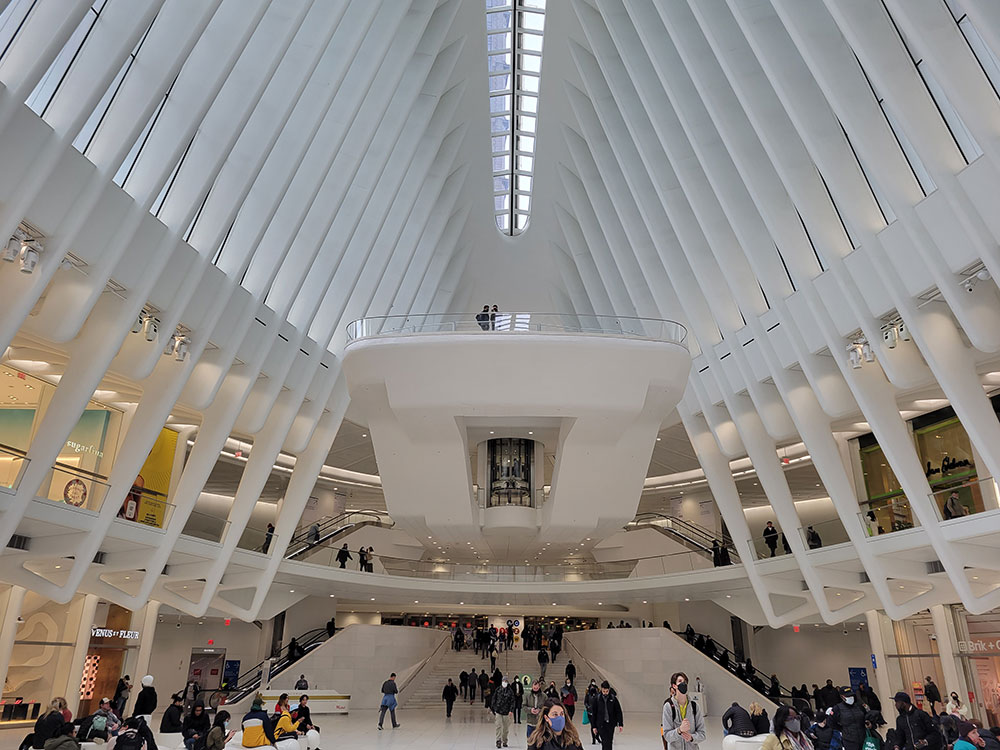
The World Trade Center station has five tracks and four platforms in the middle of a turning loop. Trains from New Jersey use the loop to turn around and head back to New Jersey. The platforms are located four floors below ground level. The floor immediately above the platforms is occupied by the station's fare mezzanine. The New York City Subway's WTC Cortlandt station is adjacent to and above the mezzanine.
The $4 billion Oculus station house, designed by the Spanish architect Santiago Calatrava, consists of white ribs that interlock high above the ground. The interior of the station house contains two underground floors, which house part of the Westfield World Trade Center mall. The transportation hub connects the various modes of transportation in Lower Manhattan, from the Fulton Center in the east to the Battery Park City Ferry Terminal in the west, and includes connections to various New York City Subway stations. It is the fifth-busiest transportation hub in the New York metropolitan area. The new station has received mixed reviews: although the hub has been praised for its design, it has also been criticized for its high costs and extended delays.
Above the station, there are three mezzanine levels. The top two levels contain shops as part of the Westfield World Trade Center. The first mezzanine level below ground also contains the Cortlandt Street-Greenwich Street station for the 1 train and a direct entrance to the northbound platform. A connection to the Cortlandt Street-Church Street station's southbound platform, for the N, R, and W trains, is located at the far east end of the mezzanine, past the mall's shops. The second mezzanine level contains the entrances to the station, as well as more connections to the subway. The third mezzanine level, located directly above the platform, contains the fare control and access to the platforms.
The station design received critical acclaim. In 2004, Herbert Muschamp, architecture critic for The New York Times, compared the design to the Bethesda Terrace and Fountain in Central Park. He congratulated the Port Authority for hiring Calatrava, and predicted that the new station would be able to impact the city's future. Muschamp continued that the architect's vision "should satisfy those who believe that buildings planned for ground zero must aspire to a spiritual dimension." Another New York Times critic, Michael Kimmelman, wrote that the PATH hub was appropriate for the World Trade Center site, as it would be "a major cultural contribution" to the New York City skyline. A committee for Manhattan Community Board 1 called the station design "beautiful" in 2005.
Calatrava described the original design as representative of "a bird being released from a child's hand". However, Calatrava's original soaring spike design was scaled back because of security issues. The New York Times observed in 2005 that the "bird has grown a beak", and that because of the new security features, the station might "now evoke a slender stegosaurus more than it does a bird". The design was further modified in 2008 to eliminate the opening and closing roof mechanism because of budget and space constraints.
A Curbed NY reporter wrote in 2015, "The platform's mezzanine level ... is kind of amazing and shows off the station's soaring ribbed structure", but other reviews derided the station redesign as being more gaudy than utilitarian. In 2014, Benjamin Kabak, a blogger writing for The Atlantic's CityLab, criticized the emphasis placed on form over function, citing design flaws driven by aesthetic choices that detract from the station's usability as a transit hub. He stated that the staircases could not accommodate the number of passengers using the station during rush hours, and that any leaks caused the marble floors to become slippery. Kabak also said that "the PATH Hub is shaping up to be an example of design divorced from purpose." Steve Cuozzo of the New York Post described the station in 2014 as it was being built as "a self-indulgent monstrosity" and "a hideous waste of public money".Michael Kimmelman, architecture critic for The New York Times, referred to the structure as "a kitsch stegosaurus". In 2015, as the station neared completion, New York magazine referred to the hub as a "Glorious Boondoggle" and, while withholding final judgement on the unfinished structure, did note the "Jurassic" appearance. When the station opened in 2016, the New York Post editorial board called the hub the "world's most obscenely overpriced commuter rail station — and possibly its ugliest", deeming the transit hub a "white elephant" and "monstrosity", comparing the Oculus to a "giant gray-white space insect".
This article uses material from the Wikipedia article "World Trade Center station (PATH)", which is released under the Creative Commons Attribution-Share-Alike License 3.0
